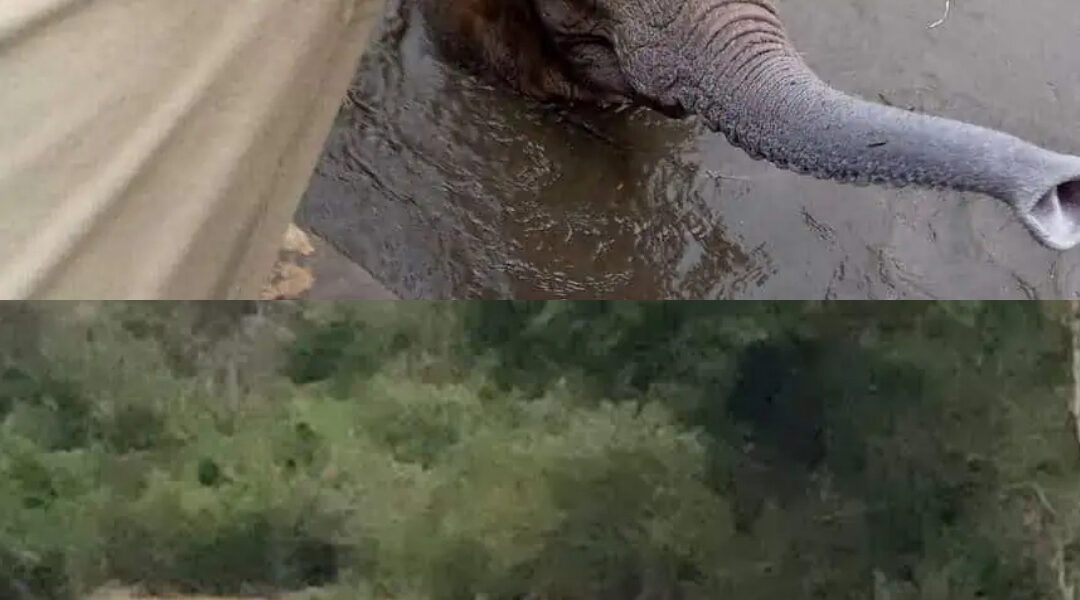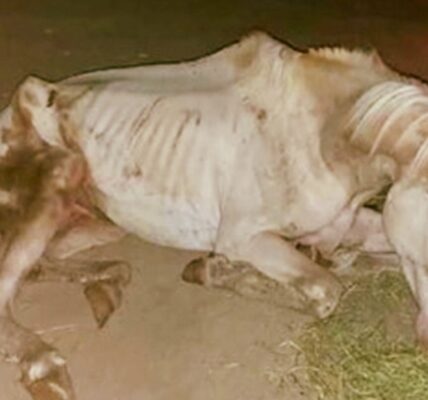In the quiet heart of Kenya’s Arabuko-Sokoke Forest, where the first light of morning filters through ancient trees and the world wakes slowly, a small drama began to unfold—one that would test courage, patience, and the unspoken bond between humans and the wild.
It started just after sunrise.

A juvenile elephant, barely steady in its growing legs, wandered too close to a concrete water trough. Its mother was only a few steps ahead, grazing peacefully, unaware of the danger her curious calf was tiptoeing toward. One misplaced step on the slick edge, one tiny slip—and the young elephant toppled in.
The splash echoed through the forest.
At first, the calf tried to climb out. Its legs scrabbled desperately against the cold stone. The more it struggled, the deeper it slipped. Panic set in. Every trumpet was a plea for help, frightened and raw.
Within seconds, the mother spun around.

Her massive frame thundered across the clearing. She trumpeted back—deep, powerful, trembling with fear. An older sibling ran beside her, pacing anxiously, circling the trough as the baby cried.
The mother pressed her trunk against the concrete, reaching, nudging, pushing—trying everything a mother could. But the walls were too steep. The calf was too small. And in that moment, even a giant felt helpless.
From a distance, rangers from the Kenya Wildlife Service (KWS) had already begun to gather. Their binoculars confirmed the worst: a calf trapped, a mother panicking, and the shadow of danger looming. Not just from the situation itself—but from another enemy that still stalked the forest:
Poachers.
A distressed elephant family was vulnerable. Loud calls carried through the trees like a beacon.
The rescue team knew time was running.
But there was another complication—the mother.
Terrified and protective, she circled the trough relentlessly. Every time a ranger stepped forward, she charged. Not out of anger, but out of love. She would rather face down a truck than let anyone near her baby.
The team needed help. The kind of help that could come from the sky.
They called the Sheldrick Wildlife Trust helicopter—but it was already deployed for a human-wildlife conflict emergency hours away. The minutes stretched like hours. The calf’s cries softened into exhaustion. The mother, frantic and panting, kept watch.

Finally, a new call came through.
The KWS helicopter in Nairobi was airborne—vet onboard, equipment ready, blades slicing through the air as it sped toward Arabuko-Sokoke.
Those waiting on the ground would later say they could hear the hope before they saw it.
The distant hum.
The growing rhythm.
The thunder of rotors approaching.
The helicopter hovered above the forest, whipping leaves into a frenzy. The pilot assessed the situation in seconds. The mission would need precision, patience, and a soft touch in a place where elephants had every reason to fear humans.
Working in careful formation, the pilot began guiding the mother gently away from the trough—not with darts, not with force, but with movement and presence, nudging her just enough to create a window of safety.
She resisted.
She hesitated.
But for a single breathless moment, she stepped far enough back.
And that was all the rescue team needed.

Rangers rushed forward.
Two slid ropes under the calf’s belly. Another supported its head to keep it above the water. The vet, steady and calm, coordinated every lift, every pull. The calf, exhausted but still fighting, tried to help with its trembling legs.
For a heartbeat, the world seemed to stop.
Then—with one final heave—the young elephant was lifted free.
Its feet touched the earth. Its body wobbled. But it was alive.
What happened next was something none of the rescuers would ever forget.
The calf let out a soft, trembling cry—not of fear, but recognition.
From the edge of the clearing, the mother answered with a roar so powerful it vibrated through the ground. The older sibling joined her, sprinting forward.
The baby stumbled toward them.
The reunion was not loud.
It was not dramatic.
It was something quieter, purer—an emotional gravity that pulled them together.
The mother wrapped her trunk around her child, touching its sides, checking its legs, sweeping its ears as if counting every inch to make sure it was real. The sibling pressed in close, rumbling softly, refusing to leave its side.
Some rangers wiped their eyes. Others simply stood in silence.
Because in that moment, they were not rescuers and animals.
They were mothers and sons.
Brothers and sisters.
Families who knew what it meant to almost lose someone you love.
The forest, which had felt so tense moments before, softened.
Birds returned to their branches.
The wind shifted gently through the trees.
And in the middle of it all, an elephant family stood together again—unbroken.
The helicopter pilot watched from above until the little one began to walk steadily, tucked safely between its mother and sibling. Only then did he lift the aircraft higher, circling one last time in quiet triumph before turning back toward Nairobi.
On the ground, the ranger teams packed their equipment slowly, still replaying the rescue in their minds. Many had seen tragedy. Many had witnessed loss. But today—today was different.
Today, the forest had given them a miracle.
The Arabuko-Sokoke Forest has endured drought, poaching, habitat loss, and the relentless pressures of a world that grows smaller by the year. Yet scenes like this remind us that resilience is written into the lives of those who call it home.
It is found in a mother who refuses to give up.
In a calf that keeps fighting.
In a team of humans who choose compassion over convenience.
In a community that refuses to let nature fade quietly into history.
The rescue of the little elephant was more than an operation.
It was a promise—
that as long as there are people willing to stand guard, these great beings will not stand alone.
And somewhere deep in the forest, under the shade of towering trees, a young elephant walks beside its mother—stronger, safer, and carrying the memory of the day the world reached out a hand and lifted it back to life.




